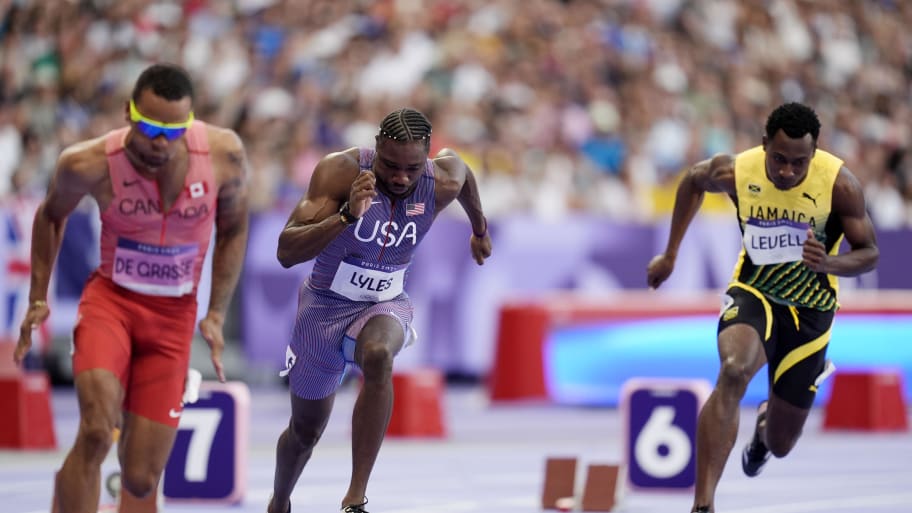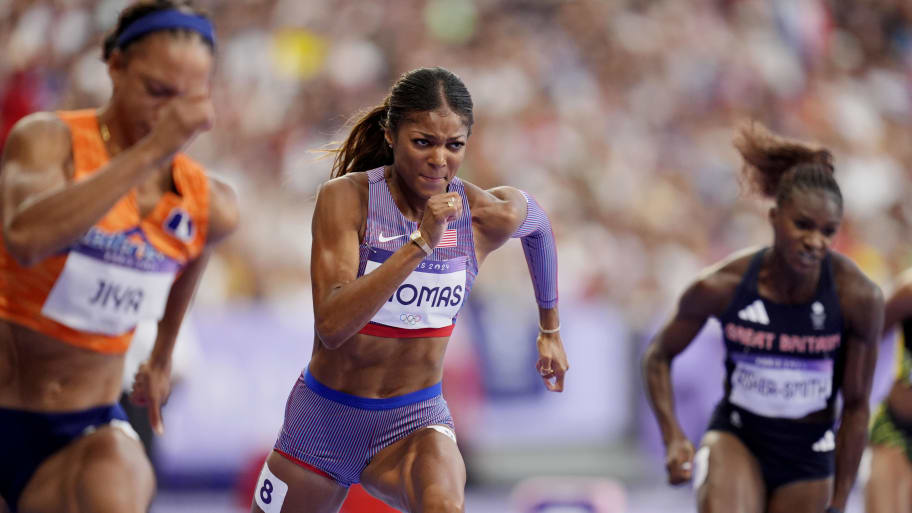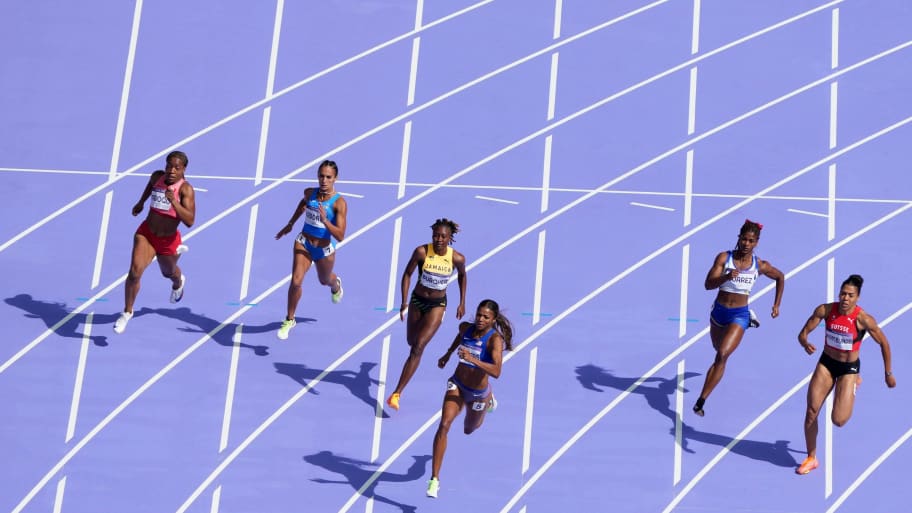
PARIS — Sure, he’s biased. But, as Michael Johnson—200-meter artist and the event’s world record holder for 13 years—notes, that doesn’t make him wrong. The 200, he argues, forms an ideal blend of sprint poetry, combining power, speed and endurance.
It’s tactical and strategic, but only briefly, at one or two points in any race. It requires “different energy systems than the 100,” he says, which requires more endurance work in training and speed that’s still blur fast. The 200 is precision. It involves form, technique, horsepower and split-second decisions made at top speed. The strategy can change depending on which lane a competitor is in. The 200-meter race is part 100, part 400; brains and muscle equally important.
Before he broke the world record in the 200, Johnson primarily trained for the 400-meter run. More typically, 100-meter specialists extend their power into twice the distance. Many still struggle to adjust. They typically need to add endurance, along with understanding that they cannot sprint as fast they can in a straight line for twice the distance. They must decide, Johnson says, where “they want to put most of their speed, most of their energy.”
“But some people can run it all out, like I could, because of my 400-meter background and base,” Johnson says. “But also because I had extraordinary speed.” He says that last part dispassionately, because it’s true, and it doesn’t sound like bragging.

There’s an art to this race. Most typically it centers on decisions, many made in the precious seconds spent navigating the turn. In most world-class competitions, the best 200 artists will make one technical decision, maybe two. Some are already better curve runners, and they will deploy more energy as the race turns, attempting to remain near or ahead of the pack. Others should be considered straightaway specialists, and they will blaze from the starting blocks, conserve as much energy as possible through the turn and then hit max velocity toward the finish line. By the time they get there, Johnson says, the race is over.
Every second matters, as does every strategic decision, every technical movement, every step on the purple track at Stade de France. Those 200-meter savants must understand themselves, as athletes, what they’re capable of and what their competitors can do. The 200, he says, is trial and error—and “error, at this level, means losses.”
In the coming days in Paris, the art will take center stage in both the men’s and women’s 200-meter competitions. Noah Lyles—owner of the fourth-best 200 time ever, 0.01 ahead of Johnson’s former world record—will take aim at the current mark, set by Jamaica’s Usain Bolt in 2009. He’ll need to shave 0.13 seconds off his best time, 19.31 seconds. He’ll compete against a field of elite sprinters—and against that clock.
In the women’s final, American Gabby Thomas is now the gold-medal favorite, after two-time reigning 200-meter world champion Shericka Jackson of Jamaica pulled out of the semifinal heats right before the race. Thomas had never defeated Jackson in the 200.
All understand the art that Johnson is describing. Lyles, in fact, released a video on YouTube in June 2023. It runs for more than 10 minutes. It’s equally informative and hilarious. It’s technical, the art of the 200 broken into individual components.
This, because he is Lyles, is how it starts: So, first things first, the 200? It’s a beautiful woman. You gotta treat it like such. It’s not the 100. It’s not hard. It’s not aggressive. It’s finesse. It’s pretty. It’s sexy.
Each component, added up, begins to prove his points. Lyles doesn’t care which way any sprinter points their starting blocks. He prefers straight ahead; not in, toward the turn, or out, toward the stands. But that’s a choice where only personal preference matters. He wants his body to shoot forward, straight ahead, for the first few steps. After those, he gauges where he’s sprinting in his lane—in the middle, always, is the ideal.
Past 10 meters, he’s driving, legs churning, slowly “putting more force into the ground.”
Around 20 meters, his body, hips and chest slowly begin to rise. No jerking, hence the ramp up.
After 30 meters, his hips come underneath him, his chest rises and his shoulders remain forward, as he drives down the track. At that point, he wants to be standing up, raising his knees high and stamping them right back down on the track like pistons. “Pushing your momentum down the track, almost as if, like, you’re falling,” he says in the video.

He gauges, again, his placement within his lane. If he’s too inside, he’s “cutting that stride” too much, losing energy and speed. If he’s outside in his lane, he’s running “too much track.” Think: golfer who bombs drives but elongates holes by spraying them far right or far left.
At 50 meters, he must make “probably the most difficult decision” in that race. How am I going to stay in the middle of the lane? Many coaches, he says, tell sprinters to lean in at the turn. “That’s not accurate.” He wants to turn his hips, gradually, and the comparison he invokes—a car’s headlights—makes his point easy to understand, even though he calls them “light beams.” He holds both hands near his hips to demonstrate. Lean and those light beams point right, toward the stands. Gradually turn the hips and they point the same way as the body.
At 75 meters, maybe 80, “It’s time to start putting power into the ground, as you’re coming out of this turn,” he says. “If you let up, in this part of the turn, you will not get the effect of all the work you did back there.”
Another check of lane positioning. Then, more power, more speed. “So we can continue to have that energy that we built up, flowing with us, going down the track. Now, this is where you’re going to feel the best momentum.”
As the turn gives way to the straightway, the final sprint toward the finish line, Lyles says many athletes “release” their body, meaning they start to relax. This can push their momentum outside of their lane, or force them to “cut” the turn at too drastic of an angle, slowing the very momentum they just created. “And, because you made that move down [on the transition from turn to straightaway], the track is gonna spit you out, almost like a slingshot. Think of NASCAR. They go up high on the hill, and they come back down. It’s the exact feeling you’re gonna feel.”
Interestingly, Lyles breaks the 200 into two, separate 100-meter aims. At 30 meters of the second 100, he says, it’s time to commit—to body position, to knees hammering into the track, to keeping those shoulders forward. If those go back, energy escapes upward, unnecessarily. “I’m gonna ask you: what’s your favorite cloud? And, if you tell me, you failed.”
At 180 meters, mental focus becomes paramount. Sprinters must follow what their coaches taught them, as close as possible to their chosen ideal form. In all likelihood, their top-end speed is gone. They have two choices: hold it, or slowly begin to slow. Even then, “It needs to look pretty, he says. “Again, the 200 needs to be finessed.”
Finally, the dip. Not too early. Not too late. “The very two last meters,” Lyles says.

That’s the art, his version, one that Al Joyner—the longtime, respected track coach—understands well. His late wife, Florence Griffith-Joyner, still holds the women’s 200-meter world record (21.34 seconds), set at the Seoul Olympics in 1988. The women’s race, he says, “will be amazing, ridiculous, because they’re so ready.”
Thomas, her mother Jennifer Randall says, “was born athletic.” She took up soccer, karate, softball, lacrosse, golf and tennis. Even as a toddler, when Thomas scampered down a hallway, mom says it appeared as if “she was floating on air.”
“Superfast,” Randall says, “even then.”
Thomas does a million things, impacts thousands of people and runs really fast while balancing an unfathomable docket of ambition. She went to Harvard, won bronze in the 200 at the Tokyo Games (and gold in the 4X100-meter relay), got her Master’s degree from Texas, took silver at the most recent world championships, then dominated the U.S. Olympic trials back in June. She’s famous, smart, fast as hell and nice. But that combination can mask what she’s like on the track, especially in the 200. Summarized, in a word: fierce.
Her best friend, Ngozi Musa, who also ran the 200 and other sprints at Harvard alongside Thomas, says she always saw the smiling speedster precisely that way. In Thomas’s freshman season, she finished sixth at Olympic trials but came across as polite and lovely afterward. But don’t mistake that bearing for how she felt. She was pissed.
“She’s a force to be reckoned with,” Musa says. “She attacks the 200.”
Johnson, another 200-meter artist, couldn’t agree more. He calls Thomas a “peerless competitor, but one of those people who doesn’t always wear that outside the track and can actually be a normal person.”
“You know, her and Noah are in interesting positions,” he says. “Sha’Carri [Richardson], too. With each, there is tremendous talent, there is some success, but they haven’t won the big one, so to speak, yet. That will be on their minds. I was there in 1996, because in ’92, I was a world champion and heavy favorite to win the 200 at the Olympics, and I didn’t win. You don’t want that to be a burden.”
Add that pressure to the art of the 200-meter race. For Lyles, Thomas or anyone else, the hope is that the art will yield one thing: gold.
This article was originally published on www.si.com as The Art of Running the 200-Meter Race: Noah Lyles Breaks Down What It Takes to Win.







